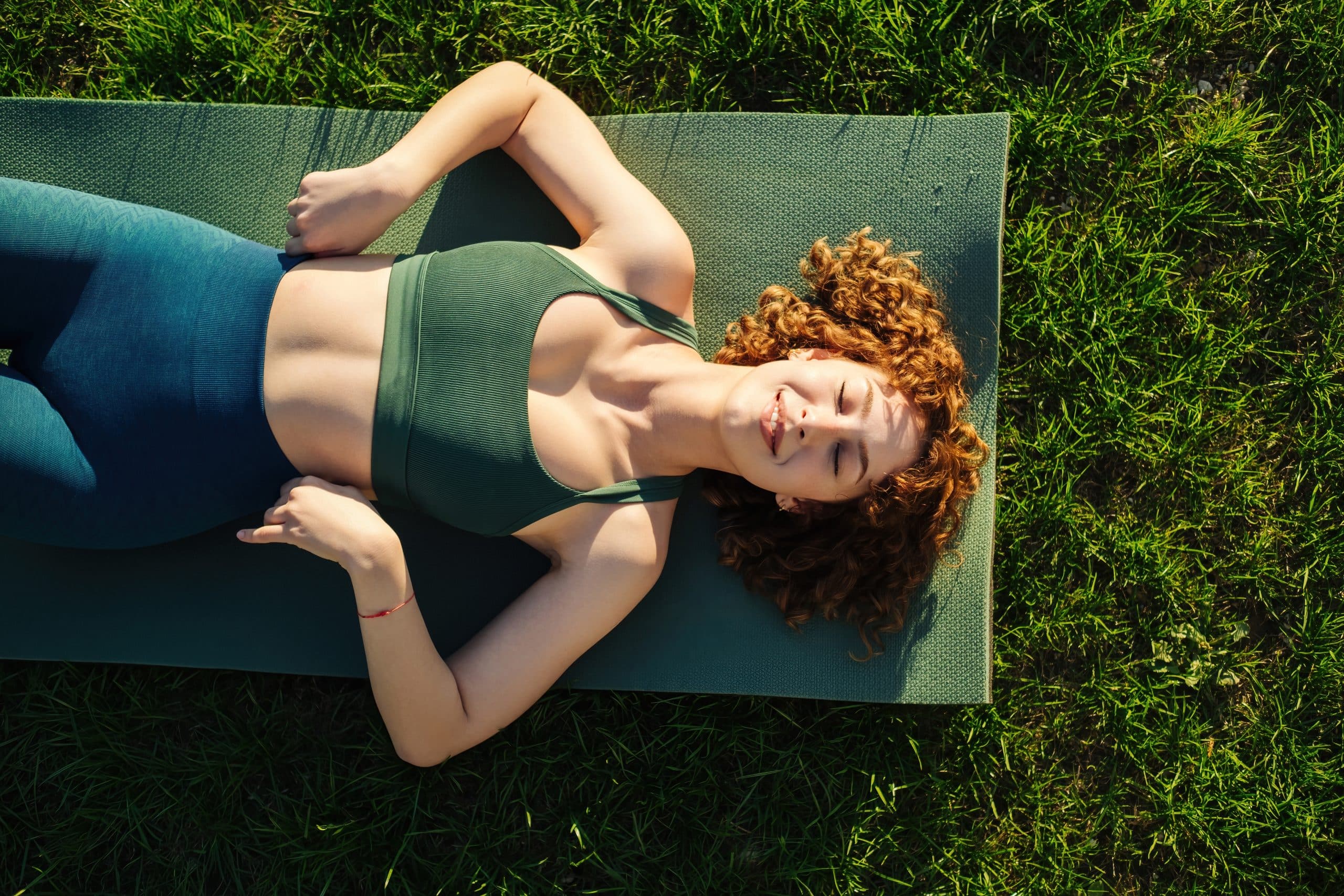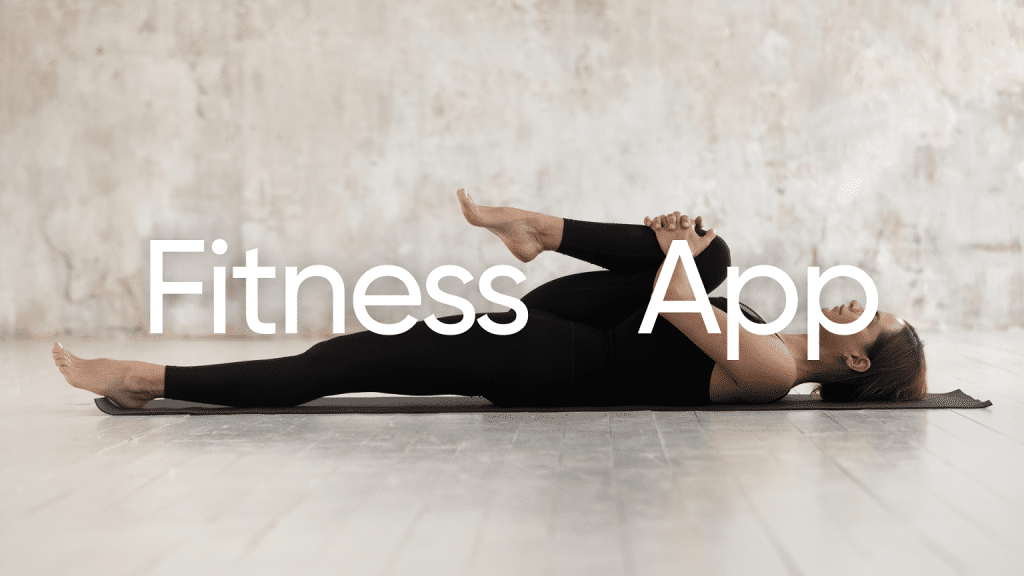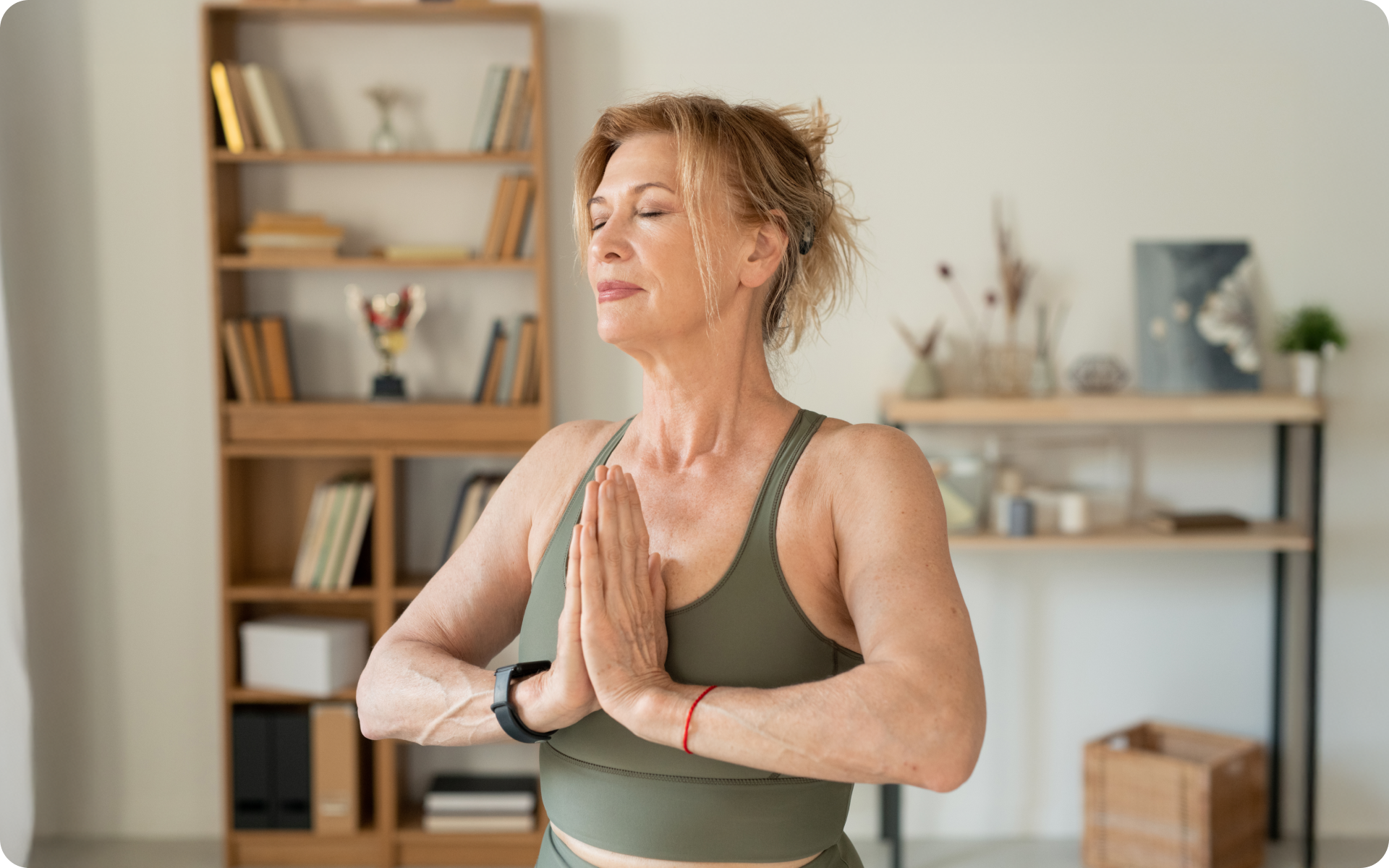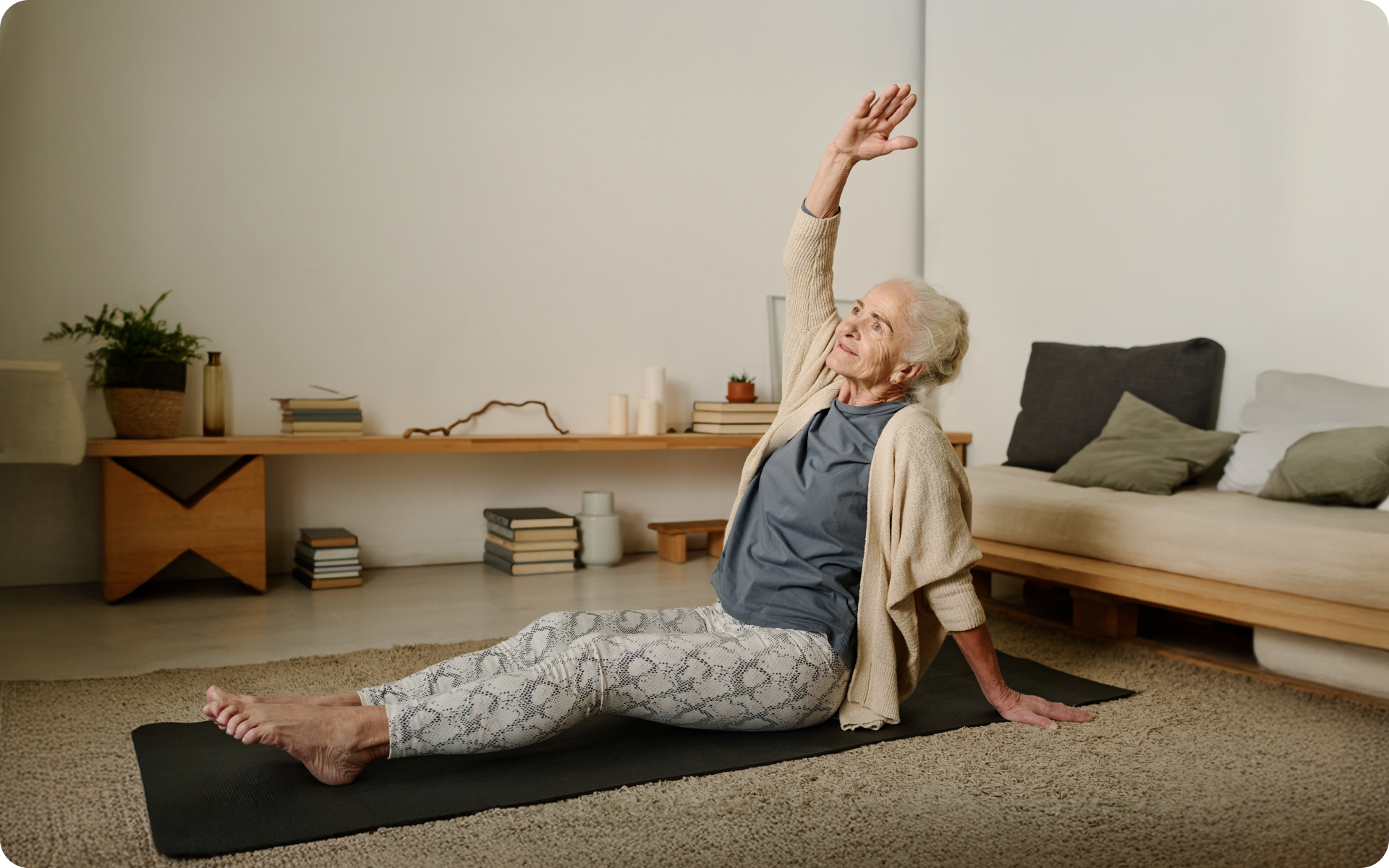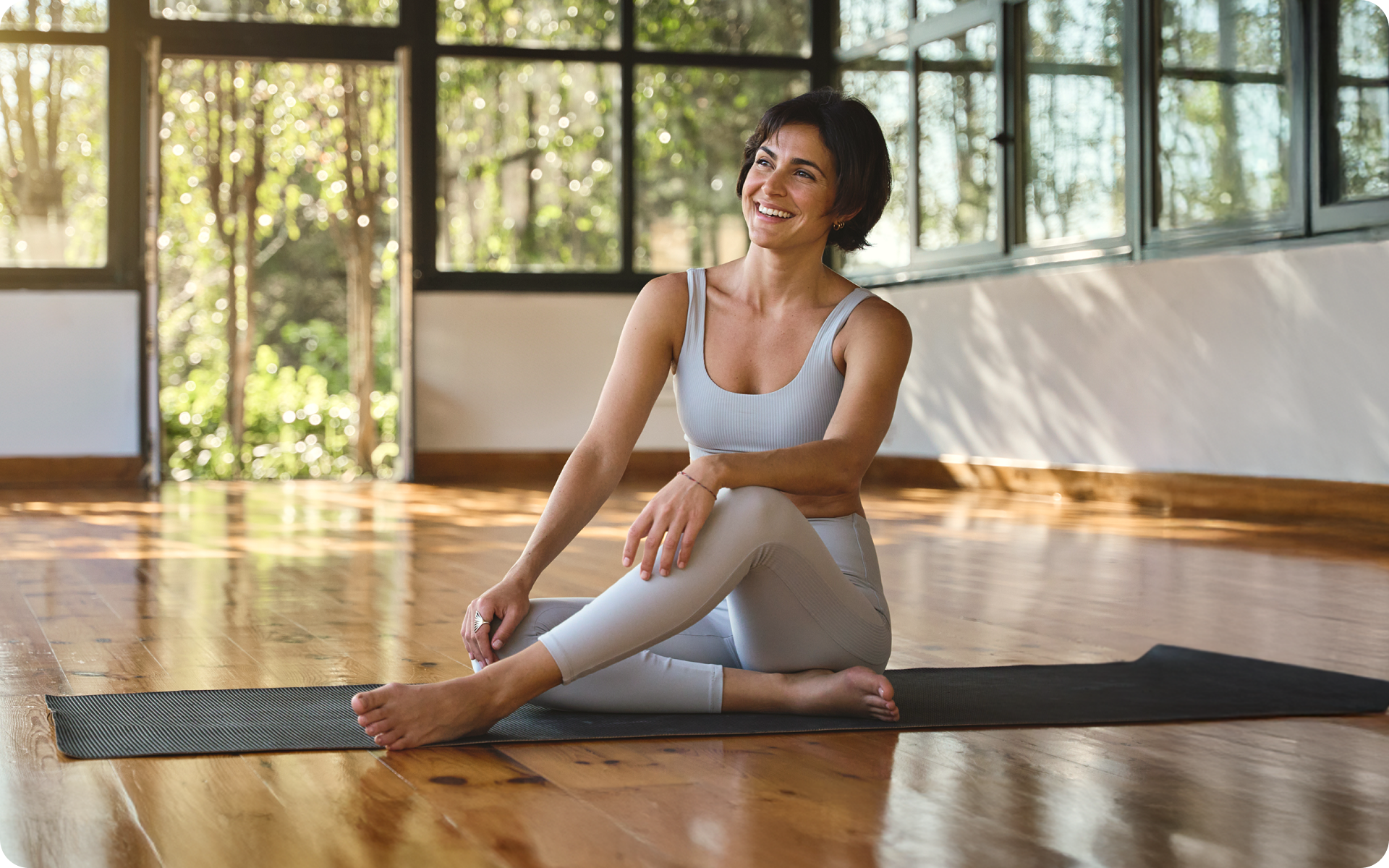Lying on your back is not only a comfortable resting position, but it also serves as the foundation for various yoga poses which can greatly enhance your practice. These supine poses offer numerous benefits, such as improving flexibility, promoting relaxation, and reducing stress (1). Suitable for beginners and experienced yogis alike, the ‘lying on your back’ poses will help you discover a practice that is truly invigorating and satisfying. This article will provide you with a comprehensive guide to seven variations of ‘lying on your back’ yoga poses which can seamlessly be incorporated into your regular routine. You’ll also find helpful information about the benefits of each pose, plus helpful tips to maximize their effectiveness.
Get your personalized
meal plan!
How Many Yoga Poses Are There?
This is a hard question to answer because there isn’t a definitive number of yoga poses, as the practice has evolved and expanded over thousands of years.
However, it is estimated that there are around 300 to 400 primary yoga poses, with countless variations and modifications (4). Yoga has its roots in ancient India, and its development has been influenced by various spiritual and philosophical traditions.
As yoga continues to grow in popularity worldwide, new poses and styles are continually being introduced, making it a dynamic and ever-changing practice.
What Yoga Pose Is Lying Down?
Yoga poses that involve lying down are typically referred to as supine or reclining poses.
These poses are designed to promote relaxation, reduce stress, and gently stretch various muscle groups. They often serve as restorative postures, allowing the body and mind to release tension and find balance (1).
One of the most well-known lying down yoga poses is Savasana, also known as Corpse Pose. In this pose, the practitioner lies flat on their back with their arms and legs relaxed at their sides, palms facing up, and eyes closed.
The yogic belief behind Savasana is that it allows the body to fully absorb the benefits of the practice by providing a moment of stillness and deep relaxation. It also serves as a symbolic reminder of the impermanence of life and the importance of letting go.
Other lying down poses include Supta Baddha Konasana (Reclining Bound Angle Pose), which opens the hips and chest, and Supta Padangusthasana (Reclining Hand-to-Big-Toe Pose), which stretches the hamstrings and calves.
These supine poses work by using gravity to gently open and elongate muscles, while also encouraging the practitioner to focus on their breath and cultivate mindfulness.
Lying down yoga poses can be particularly beneficial for individuals recovering from injuries, those with limited mobility, or anyone seeking a gentle and restorative practice. They provide a safe and accessible way to experience the physical and mental benefits of yoga.
Read More: Transform Your Workspace With 10 Chair Exercises For Lower Back Pain
7 Variations Of Lying On Back Yoga Pose
Below are 7 yoga poses while lying on your back:
Savasana (Corpse Pose)
Savasana is a deeply restorative pose that promotes relaxation and stress reduction, allowing the body and mind to fully absorb the benefits of the yoga practice. This yoga pose is often performed at the end of a session to facilitate integration and rejuvenation.
Steps to execute Savasana:
- Lie flat on your back with your legs extended and slightly apart, allowing your feet to fall naturally to the sides.
- Place your arms alongside your body, palms facing up, and relax your shoulders away from your ears.
- Close your eyes and take slow, deep breaths, focusing on the rise and fall of your abdomen.
- Allow your body to feel heavy, releasing tension in your muscles and joints.
- Remain in Savasana for 5-10 minutes, or longer if desired.
- To exit the pose, gently wiggle your fingers and toes, roll onto one side, and slowly push yourself up to a seated position.
Supta Baddha Konasana (Reclining Bound Angle Pose)
Supta Baddha Konasana is a gentle hip opener that also helps to stretch the inner thighs and groin. This pose encourages relaxation and can be particularly beneficial for those experiencing stress, anxiety, or menstrual discomfort (2).
Steps to execute Supta Baddha Konasana:
- Lie on your back with your knees bent and feet flat on the floor.
- Bring the soles of your feet together, allowing your knees to open out to the sides like a butterfly.
- Adjust your feet closer to or farther from your pelvis, depending on your comfort and flexibility.
- Place your hands on your belly or rest them alongside your body, palms facing up.
- Breathe deeply and allow your hips to release and relax.
- Hold the pose for 3-5 minutes.
- To exit, use your hands to gently close your knees together and extend your legs.
Supta Padangusthasana (Reclining Hand-To-Big-Toe Pose)
Supta Padangusthasana is a supine hamstring stretch that also targets the calves and lower back. This yoga pose lying on back feet up may help improve flexibility, alleviate lower back pain, and promote digestion (3).
Steps to execute Supta Padangusthasana:
- Lie on your back with both legs extended.
- Bend your right knee and hug it into your chest.
- Loop a yoga strap or towel around the ball of your right foot, holding the ends with both hands.
- Straighten your right leg toward the ceiling, keeping your left leg grounded and active.
- Gently pull the strap to deepen the stretch, ensuring that your shoulders remain relaxed.
- Hold the pose for 30 seconds to 1 minute, breathing deeply.
- Release the strap and switch to the left leg.
- After completing both sides, bend your knees and roll to one side to sit up.
If you wish to free yourself from all the extra pounds that have been weighting you down for way too long, start using the BetterMe app and overhaul your entire life!
Supta Matsyendrasana (Reclining Spinal Twist)
Supta Matsyendrasana is a gentle spinal twist that helps to release tension in the lower back, hips, and shoulders. This yoga pose is done while lying on your back, feet together also aids in digestion and stimulates the abdominal organs (3).
Steps to execute Supta Matsyendrasana:
- Lie on your back with your knees bent and feet flat on the floor.
- Extend your arms out to the sides in a T shape, palms facing down.
- Keeping your knees together, lower them to the right as you turn your head to the left.
- Place your right hand on your left knee to encourage a deeper twist.
- Breathe deeply and hold the pose for 30 seconds to 1 minute.
- Inhale to lift your knees back to center, then repeat on the opposite side.
- To exit, hug your knees into your chest and gently roll up to a seated position.
Supta Virasana (Reclining Hero Pose)
Supta Virasana is a deep quad and hip flexor stretch that also opens the chest and shoulders. This lying on back in yoga pose can help improve posture and alleviate discomfort in the lower back and knees (2).
Steps to execute Supta Virasana:
- Begin in Virasana (Hero Pose) with your knees together and your feet flanking your hips.
- Use your hands to support your weight as you lean back, first placing your elbows on the ground.
- If comfortable, lower your upper body all the way down, resting your head on the floor or a bolster.
- Extend your arms overhead or rest them alongside your body, palms facing up.
- Breathe deeply and hold the pose for 30 seconds to 1 minute.
- To exit, press your forearms into the ground and lift your torso back up to Virasana.
Supta Gomukhasana (Reclining Cow Face Pose)
Supta Gomukhasana is a powerful hip opener and hamstring stretch that also targets the shoulders and chest. This pose can help release tension in the hips and improve overall flexibility (2).
Steps to execute Supta Gomukhasana:
- Lie on your back with your knees bent and feet flat on the floor.
- Cross your right knee over your left, stacking them as closely as possible.
- Reach for your feet or ankles, drawing your heels toward your hips.
- Allow your head and shoulders to rest comfortably on the ground.
- Breathe deeply and hold the pose for 30 seconds to 1 minute.
- Release your legs and switch sides, crossing your left knee over your right.
- To exit, uncross your legs and extend them out in front of you.
Supta Ananda Balasana (Reclining Happy Baby Pose)
Supta Ananda Balasana is a gentle hip opener that also stretches the inner thighs and groin. This pose can help to release tension in the lower back and hips, as well as calm the mind (2).
Steps to execute Supta Ananda Balasana:
- Lie on your back and hug your knees into your chest.
- Grab the outer edges of your feet or your big toes with your hands.
- Keeping your knees bent, open your legs wider than your torso and draw them toward your armpits.
- Gently press your feet into your hands while maintaining a neutral spine and relaxed shoulders.
- Hold the pose for 30 seconds to 1 minute, breathing deeply.
- To exit, release your feet and extend your legs along the floor.
Read More: Chair Yoga For Core Strength: The Ultimate Guide
How Many Yoga Poses Over 30 Minutes?
The number of yoga poses that can be done in 30 minutes depends on the style of yoga, the pace of the practice, and the individual’s experience level.
As a general guideline, a 30-minute yoga practice might include around 15-20 poses. However, this can vary based on factors such as:
Style Of Yoga
A slower, more restorative practice may include fewer poses, held for longer durations, while a faster-paced, dynamic practice like Vinyasa may involve more poses with shorter holds.
Pace Of The Practice
If you prefer to move more slowly and focus on alignment and breath, you might choose to do fewer poses. On the other hand, if you enjoy a quicker flow, you may incorporate more poses within the 30-minute timeframe
Experience Level
Beginners may benefit from a slower pace with fewer poses to ensure proper technique and avoid injury, while more advanced practitioners might be comfortable with a greater number of poses executed at a faster pace.
Ultimately, the number of poses in a 30-minute practice will vary based on individual preferences and goals. It’s essential to listen to your body, prioritize proper alignment, and maintain a steady breath throughout your practice for the best results.
Yanking yourself back in shape has never been so easy with our game-changing fitness app! Start transforming your life with BetterMe!
How Many Yoga Poses Per Session?
The number of yoga poses per session can vary greatly depending on factors such as the style of yoga, the duration of the practice, the individual’s experience level, and personal preferences. In general, a well-rounded yoga practice might include anywhere from 10 to 25 poses or more.
The key is to create a balanced practice that includes a mix of poses targeting different muscle groups and aspects of your well-being, such as flexibility, strength, balance, and relaxation.
You may also want to incorporate warm-up poses, standing poses, seated poses, twists, inversions, backbends, and a final relaxation pose like Savasana.
Remember that the quality of each pose and your ability to maintain proper alignment and breath control are more important than the quantity of poses in your practice.
Make sure to listen to your body and adjust your practice accordingly to ensure a safe and enjoyable yoga experience.
Conclusion
Incorporating these seven ‘lying on your back’ yoga poses into your practice can offer numerous benefits, from increased flexibility and relaxation to reduced stress and tension.
By regularly integrating these supine poses, you can create a well-rounded and transformative yoga experience that supports both your physical and mental well-being.
DISCLAIMER:
This article is intended for general informational purposes only and does not serve to address individual circumstances. It is not a substitute for professional advice or help and should not be relied on for making any kind of decision-making. Any action taken as a direct or indirect result of the information in this article is entirely at your own risk and is your sole responsibility.
BetterMe, its content staff, and its medical advisors accept no responsibility for inaccuracies, errors, misstatements, inconsistencies, or omissions and specifically disclaim any liability, loss or risk, personal, professional or otherwise, which may be incurred as a consequence, directly or indirectly, of the use and/or application of any content.
You should always seek the advice of your physician or other qualified health provider with any questions you may have regarding a medical condition or your specific situation. Never disregard professional medical advice or delay seeking it because of BetterMe content. If you suspect or think you may have a medical emergency, call your doctor.
SOURCES:
- Exploring the therapeutic effects of yoga and its ability to increase quality of life (2011, nih.gov)
- Health Impacts of Yoga and Pranayama: A State-of-the-Art Review (2012, nih.gov)
- How Yoga Can Improve Digestion – 8 Yoga Poses for Better Digestion (n.d., arhantayoga.org)
- Yoga Poses for Beginners: Why Yoga Modifications Are Important (2022, clevelandclinic.org)
